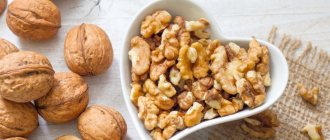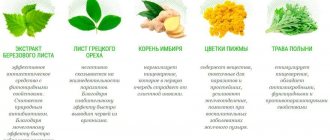Walnuts are called one of the healthiest fruits in the world. Persia (now Iran) is considered their homeland, and their “biography,” according to scientists, began tens of thousands of years ago. During this time, it became overgrown with legends about the powerful power of trees, the fruits of which resemble the human brain.
The ancient Greeks called nuts the acorns of the gods and considered them an aphrodisiac that awakened extinguished feelings. Traditional healers made a potion for female infertility, the basis of which was walnuts with honey.
The Romans had a tradition of throwing walnuts at the bride and groom. Newlyweds were required to have medicinal fruits in stock. This served as a guarantee of the birth of children.
The great healer Avicenna advised including kernels in women’s diets to restore strength and saturate the body with useful substances. The fruits were part of the famous Hippocrates paste, which was used to treat the heart. In Tsarist Rus', the nut was called the “tree of life,” and biologist Ivan Michurin was called the bread of the future.
Everything about a walnut is useful: from the tops to the roots. In folk medicine, unripe flowers, leaves, fruits, bark, and roots are used. The shell, kernels and internal partitions have powerful powers.
Nuts, which were called “walnuts” in Rus', are called differently in each state. The ancient Romans simply referred to fruits as “nuts.” The ancient Greeks called them “Persian”, “royal”, because they knew about their place of origin. By the way, in ancient Persia only members of the royal family enjoyed the fruits.
When is Walnut Day celebrated?
In June 1949, the United States proposed an annual observance of National Walnut Day. This was done to popularize the royal nut. And on March 3, 1958, the 34th President Dwight David Eisenhower issued an official statement that this day was now fixed for May 17, then the celebration of the first National Walnut Day took place.
Ripe walnut
After 40 years
After 40 years, walnuts must be introduced into the diet. Proteins and vegetable fats will slow down skin aging and the appearance of wrinkles, activate brain function and help restore intestinal function. Walnut oil will not only help get rid of constipation, but also improve kidney function. In the morning, on an empty stomach, you need to take 1 tablespoon of oil.
At this age, bone density decreases, the risk of fractures increases, calcium in walnuts will help stop these processes.
Walnut, where did its name come from in English and Russian?
Walnut in English is walnut, the word comes from the Old English wealhhnutu, literally “foreign nut” (from wealh “foreign” + hnutu “nut”), as it was brought to England from Gaul and Italy. The Latin name for the walnut was nux, meaning "Gallic nut".
The Russian name is also associated with the origin of walnuts. Pavel Syutkin, a historian of culinary and Russian cuisine, writes: “In Russia, acquaintance with walnuts apparently occurs in the 12th-13th centuries, when close contacts were established with Byzantium. It is from there that nuts come to us, but they are called “Greek”. Then many products and objects coming from this part of the world are called “Greek”, for example, buckwheat, known to everyone (according to one version of the origin of this word).”
Walnuts were also called “royal nut”, “Greek nut” and “Voloshsky nut” in Russian.
Fruit of the walnut tree
For women over 30 years old
Nutritionists write about the benefits of walnuts for women after 30 years of age in connection with the hormonal changes that occur at this age. Hormonal imbalance can lead to diseases of the mammary glands and even oncology. The solution to the problem is tincture of walnut partitions.
- they need to be filled with alcohol or vodka (2 to 1);
- store the mixture in a cool, dark place for 3 weeks;
- take 20 drops on an empty stomach, diluting with water. Hormonal levels will improve in a month.
Vitamins of groups B and C, contained in nut kernels, slow down the aging process, groups A and E strengthen and protect the body from harmful environmental influences.
Walnuts, where do they come from? From Greece?
Walnuts, according to one of the most common versions, originated in Northern India. In the middle of the 15th century. Constantinople, the capital of Byzantium, fell under the onslaught of the Turkish Sultan. Pavel Syutkin: “Trade ties with Russia were interrupted for a long time. Around the 16th-17th centuries, their new name appeared in Rus': “Volosh nuts”. These are the same walnuts, only brought to us from Wallachia (the south of modern Romania).”
In Vladimir Ivanovich Dahl’s we find: “Nut is masculine, a tree fruit in a hard, strong shell. Sometimes they say instead of hazel and hazel, walnut or walnut tree, meaning Voloshsky nut, walnut.” By the end of the 19th century, the name “walnuts” became predominant in the Russian language.
Encyclopedic Dictionary of Brockhaus and Efron : “Walnut, Voloshsky nut (Juglans L.).”
Eggplant rolls with walnuts, see recipe here
Now, as promised, let's talk about the benefits and harms of walnuts.
Walnuts, benefits and harm. And detail?
In terms of calorie and protein content, walnuts are comparable to meat, but are easier to digest. Citrus fruits are superior in the amount of vitamins. They are recommended for vitamin deficiency, iron deficiency, as a general tonic; they have a positive effect on the blood vessels of the brain and relieve nervous tension.
Benefits of walnuts
- Memory improvement. Nuts contain omega 3 and 6 essential fatty acids, which help improve memory and cognitive function.
- Preventing depression. Research has shown that low omega-3 levels can harm your alertness and vitality. Since walnuts are high in omega-3, they help prevent depression.
- Improved motor function. Omega-3 fatty acids do wonders for the brain, including improving motor function.
- Preventing heart disease. Studies conducted in the US, Australia, New Zealand, Spain and Israel concluded that two to three servings of walnuts per day lowered cholesterol levels sufficiently to reduce the risk of coronary heart disease.
- Improvement of "masculinity". A handful of walnuts eaten every day increases the viability and motility of sperm.
- Skin beauty support. Eating walnuts helps the skin look younger - healthy and elastic. Thanks to vitamin E for this. By the way, walnut oil is a valuable cosmetic product for reducing dry skin.
- Walnuts are a source of biotin (vitamin B7), which helps keep hair and nails healthy and prevents hair loss and brittle nails. Vitamin E gives hair and nails a healthy shine.
- Help with weight management. Walnuts are high in fiber, protein, and fat, which help you feel fuller longer.
- Extra boost of energy. Walnuts contain many B vitamins (B1 - 0.39 mg, B5 - 0.82 mg, B6 - 0.8 mg, etc.). They can increase the amount of energy in the body. This definitely fits with the weight management factor. When you're energized, you're more likely to get active and burn calories! Try regularly eating walnuts with natural yogurt as an afternoon snack or a pre-workout snack.
Harm of walnuts
The dangers of walnuts are probably not entirely correct. There are some restrictions on the consumption of walnuts - that’s more accurate. Walnuts are high in calories, so consuming them in excess may lead to slight weight gain. In some people, high consumption of walnuts may be associated with diarrhea due to the nuts' high oil content. Below we will tell you exactly how many walnuts you need to eat per day so that no problems arise.
Walnuts, like other types of nuts, can cause food allergies. Currently, nut allergies are diagnosed in approximately 2% of the world's population.
Red bean pate with walnuts, see recipe.
When losing weight
You cannot lose weight with walnuts alone. Nuts contain substances necessary for a woman’s complete nutrition, but the daily allowance cannot be exceeded. A fasting “nut” day will not bring benefits to the body. Have you been prescribed a strict diet? Then walnuts should be completely excluded from the diet.
Physical activity and proper nutrition using walnuts will help you lose weight. Containing vegetable protein, it accelerates the process of replacing fat mass with muscle mass and reduces fatigue when performing sports exercises. Walnuts will help reduce the calorie content of salads and main courses, as they are an ideal substitute for butter.
Proteins and fiber contained in fruits satisfy hunger, so fruits are an excellent snack and will help you “hold on” until your main meal. They should be taken in the morning, not on an empty stomach, or before lunch, so that the body has time to expend the energy received during meals.
Are walnuts the healthiest nuts?
A very possible statement! Walnuts contain the highest amount of antioxidants compared to other types of nuts (about 2 times). Undoubtedly, they are very nutritious, but king nuts are much healthier than peanuts, almonds or pistachios.
A study by American scientists says that the antioxidants in walnuts are 2-15 times stronger than vitamin E. Meanwhile, it is known that this vitamin protects the cells of the human body from damage by natural chemicals that cause various diseases.
Walnut baklava, see recipe here
Green walnut tincture for the thyroid gland
A tincture of green walnuts is prepared in two ways. The first involves the use of vodka, the second - alcohol. The process should begin with the assembly of the main product. You will need approximately 25-30 pieces. A stale nut is not suitable for medicine; you need to pick the kernels directly from the tree.
Algorithm for preparing the drug:
- rinse green fruits well;
- cut them into circles (slice thickness – 0.5 mm);
- Fill a sterilized liter jar with preparations to 1/3 of the total volume;
- fill the container to the neck with vodka;
- put in a dark place for 2 weeks (it is recommended to keep the temperature within 20-22°C);
- After settling, strain the contents of the jar, pour the liquid into a clean glass container (preferably dark glass), close tightly with a lid.
The second version of the tincture is prepared from diluted alcohol in a similar way. The use of pure ethanol is not recommended. Under the influence of an aggressive environment, most of the beneficial microelements will disappear, causing the product to lose its healing properties.
Bottled or spring water is suitable for diluting pure alcohol. The strength should not exceed 70%.
Tincture of green kernels is used for various pathologies. Many people know the remedy as an effective cure for hypothyroidism. You can restore the functionality of the thyroid gland by taking 1 tbsp of the drug. l. three times a day. This should be done after eating, 1-1.5 hours later. The minimum course duration is 1 month.
Walnuts, why do some people soak their kernels before eating?
Some people find fresh nuts difficult to chew. Soaking walnuts in water for 1-2 hours softens them without losing nutritional value!
Walnuts are also soaked in warm water to remove the thin brown skin. This is often done when preparing cream, sauce, mousse or soufflé - something very tender and homogeneous. Pieces of skin are not needed in such dishes.
Soaking walnuts helps reduce the level of bad cholesterol in the body and such nuts are easier to digest compared to regular, dry ones. To do this, simply soak 2-4 walnut kernels overnight in 1 glass of water and eat before breakfast in the morning.
Beef kharcho soup with rice and walnuts, see recipe here
Consuming seeds for constipation: list of approved seeds
For constipation, children and adults are recommended to eat ground flax, chia, poppy seeds, as well as sunflower and pumpkin seeds. The seeds are also pre-soaked overnight and roasted in a frying pan. Are the seeds strengthening or weakening? To improve bioavailability, flaxseeds are first ground in a coffee grinder.
Important! The seeds normalize the functioning of not only the digestive tract, but also the female reproductive system. During the follicular phase, seeds rich in estrogen are consumed to mature the dominant follicle: flax in combination with sunflower. The luteal phase requires zinc and vitamin E, which pumpkin seeds are rich in.
Normalization of hormonal levels leads to improved functioning of the gastrointestinal tract and prevents constipation.
Walnuts, BZHU, content of calories, vitamins and microelements
100 g of raw walnuts contains:
- proteins – 15.2 g
- fat – 65.2 g
- carbohydrates – 13.7 g
- water – 4.07 g
- calories – 654 kcal and 2740 kJ
- fiber – 6.7 g
- sugar – 2.61 g
- calcium – 98 mg
- iron – 2.91 mg
- magnesium – 158 mg
- phosphorus – 346 mg
- potassium – 441 mg
- biotin – 2.6 mg
- vitamin E – 2.6 mg
1 serving (28 g) of walnuts contains: 2.6 g omega-3 and 10.8 g omega-6.
Simple chicken satsivi with walnuts, see recipe here
Calorie content
Name of substancesQuantity per 100 g of nutsProteins 62.4 Carbohydrates 44.4 Fats 586.8 Energy value 656 caloriesThe benefits of walnuts for women's health can be assessed by taking into account the following factors.
- The kernels are recommended for use after childbirth and surgical interventions for gynecological pathologies. The product helps to quickly restore blood loss and improves physical condition.
- Regular consumption of nuts prevents the development of varicose veins. This is worth taking note for lovers of high-heeled shoes.
- For uterine fibroids, shell tincture helps a lot.
- During menopause, in order to stabilize the psycho-emotional background, experts advise eating a handful of walnuts. This will increase the body's resistance to stress and nervous tension.
- Infusions of leaves, shells, and kernels are recommended for use in the preparation of folk remedies intended for cleansing the liver.
- The kernels help pregnant and breastfeeding women enrich the body with nutrients. The product should be added to the menu often, but in small portions.
- Regular consumption of the product helps stabilize blood pressure. Hypertensive patients should take this advice into account.
- Nuts normalize the functioning of the hematopoietic system. They are used to prevent heart and vascular diseases.
Before introducing the product into your daily menu, you should consult your doctor. This is especially true for pregnant and breastfeeding women. The recommended daily intake is 30-50 g.
Walnuts, how many cleaning methods are there?
We know 7 cleaning methods, among them there is one - the most proven one. This is buying already shelled walnuts! Not only do you not need to peel the nuts, you also immediately see the nut kernels and can evaluate the quality of the product. And what a saving of time and effort!
The remaining 6 ways to clean walnuts:
- the “door hinge” method is an adventurous method, but most often the most reliable,
- blow with a hammer; for this, do not forget to soak the walnuts in warm water for a couple of hours to soften the shells a little,
- the “bare hands” method, most suitable for strong and resilient hands; for it, two walnuts need to be pressed against each other and squeezed,
- using a sharp knife is a dangerous way to peel walnuts; suitable for experienced and dexterous people, contraindicated for children,
- the use of various gadgets and devices, including a screw press similar to the Nutcracker,
- freezing is the most original of all methods of cleaning walnuts.
Let's talk about the last cleaning method in more detail. Using a freezer to crack walnuts is due to the properties of water, which expands when frozen. Place the walnuts in a freezer-safe Ziploc bag and seal tightly. Place the sealed bag in the freezer for several hours. The water contained in the nuts and their shells freezes, expands and... the walnut shells crack.
This method is good for walnuts intended for baking. Nuts become a little soft when frozen.
Rye muffins with walnuts on Varenets, see recipe here
Walnuts, how many to eat per day?
Walnuts have a high calorie content: more than 600 kcal per 100 g. At the same time, as mentioned above, they are very healthy, so scientists and nutritionists disagree on how many walnuts you can eat per day. The average norm is 40-50 g.
If you are preparing dishes, remember that 1 glass of 250 ml contains 160 g of walnuts.
Millet porridge with pears and caramelized walnuts, see recipe here
Where does it grow and what does it look like?
The life form of a plant is a tree. Its height can be about 25 m. The trunk is thick, covered with gray bark with cracks. The crown is extensive. Its diameter can reach 20 m. The branches are covered with odd-pinnate foliage, arranged alternately. Leaf buds bloom at the same time as flower buds. The vegetation enters the flowering phase in May.
The fruits ripen in September-October. They are large drupe-like nuts. Depending on the variety, they may vary in shape, weight, and shell density. On average, the weight of one fruit varies between 5–17 g, with the kernel accounting for about 50% of the weight.
In the wild, walnuts are found:
- in Transcaucasia, Talysh Mountains;
- in northern India and China,
- in Ukraine, Greece, Asia Minor;
- in the Balkans,
- in Western Europe;
- in Southern Kyrgyzstan.
Did you know? Nuts are one of the most prolific crops. An adult tree can produce up to 300 kg of fruit per season.
The plant species in question has been cultivated for a very long time. Over the years, many new varieties have been developed. The culture has become widespread due to its taste and healing properties. The fruits of the nut are actively used for preparing various dishes, and are also consumed raw.
Walnuts, what is the best way to store them?
Fresh walnuts, properly dried, can be stored in their shells for up to 3 years.
Once refined, the oils in raw walnuts quickly become rancid. Such nuts should either be used as soon as possible - almost immediately after removing the shell, or stored in the refrigerator or freezer. Nuts can be stored in the refrigerator for six months, in the freezer - up to 1 year.
Shelled nuts sold in stores go through several stages before packaging, including pasteurization. Pasteurization ensures the safety of products by increasing their shelf life. Plus, pasteurization does not particularly affect the content of antioxidants; there are almost no fewer of them!
Feijoa jam with walnuts, see recipe here
Poisoning or allergy?
A person may not be aware of the presence of an allergic reaction to a particular product. Sometimes nut intolerance manifests itself as symptoms of mild poisoning, such as nausea, increased gas production, increased stool frequency, dry mouth, etc. However, specific reactions are more often observed:
- skin rash, urticaria;
- redness, itching and burning of the skin;
- copious nasal discharge and lacrimation;
- stomatitis, inflammation of the mucous membranes of the oral cavity;
- diarrhea, abdominal cramps.
Only a specialist can determine the causes of such reactions and prescribe treatment.
Walnuts, how can you use them?
Walnuts add crunch and flavor to baked goods and desserts - pies, breads and cakes. They are good to add to the dough for muffins, pancakes and waffles, plus to prepare homemade baklava and kozinaki. But sweets are not the only use for walnuts. Use them when preparing soups, especially thick ones, like Megrelian kharcho or steamed vegetables. Walnuts perfectly complement baked vegetables, salads, including fruit ones. Finely chopped walnuts make an excellent breading for cutlets or meatballs.
Walnuts form the basis of many sauces - for example, Georgian satsivi and bazhe. In the Caucasus, walnuts generally enjoy incredible love. In Georgia, in addition to sauces with walnuts, lobio and pkhali are prepared from vegetables, in Abkhazia they are added to green appetizers (acharkhal), in Azerbaijan they are used as a filling for lavangi fish, in Armenia - for khapama, stuffed pumpkin.
Walnuts can also be added to protein shakes and smoothies by grinding them together with other ingredients. They can be used to make homemade walnut chutney or a sauce made with walnuts, garlic, ginger, mint, lemon juice, oil, salt and freshly ground black pepper.
We will highlight three of the simplest ways to prepare walnuts. The first method is nut muesli, a multifunctional additive to ice cream, cottage cheese, yogurt, sour cream, and Varenets. To make this, pulse the walnuts in a food processor with the oats, flour and brown sugar until medium crumbly. No need to punch into flour! Mix the prepared mixture with a small amount of vegetable oil. Do not pour a lot at once, but add literally drop by drop and mix, achieving the consistency of wet sea sand. Place the mixture on a baking tray lined with baking paper and bake in an oven preheated to 180°C until crispy. Serve with berries or fruits and dairy products.
For picky children - “Wonderful nut butter.” Just mix some cocoa powder and honey. Add walnuts, pureed in a blender until finely crumbled. Stir and season with lemon or orange juice. Store the paste in an airtight jar.
And finally, we'll tell you how to make crispy walnuts. Mix 450 g of shelled nuts and 1 tbsp in a bowl. l. sea salt. Pour drinking water over the nuts and leave for 8-12 hours. Place in a sieve, quickly rinse and dry with paper towels. Spread in a single layer on a baking tray lined with baking paper. Dry at 50°C for at least 3 hours or more, depending on how crispy you like them.
Festive chocolate sausage with walnuts, see recipe here
Nuts in cosmetology
The fruits of the medicinal tree are also widely used in cosmetology. Infusions and decoctions of the nut, as well as crushed kernels, are used as the main component of products for the face and hair. Thanks to amino acids, it is possible to regulate the functioning of the sebaceous glands, enrich cells with valuable substances, and moisturize dry strands.
Walnut oil helps eliminate hair shaft fragility and stop the process of baldness. Among the huge number of masks, the following options are popular.
Nourishing face mask
Pour boiling water (150 ml) over dried plantain and St. John's wort herbs (2 tablespoons each) and bring to a boil, turning the burner to minimum. After cooling, you need to strain the broth. Add crushed walnuts (3-4 pieces) and rowan juice (30 ml).
After applying the mixture, allow it to soak in for 20 minutes. Residues are removed with warm water. It is recommended to complete the procedure by wiping your face with ice cubes.
You need to make a mask once every 1-2 weeks.
Walnut mask for damaged hair
Using a blender, grind 10 kernels. Mix the powder with olive oil (2 tbsp) and lemon juice (1 tbsp). All ingredients are thoroughly mixed and heated in a water bath. Massage the product into the scalp. A plastic scarf and a terry towel are put on top of the mask. After 40 minutes, wash your hair with a caring shampoo.
The procedures are repeated once a week for 2 months.
Walnut and celandine baths
Water procedures are useful for eliminating dermatological problems and treating pathologies of the lymph glands. The product is prepared from 1 kg of nut leaves (fresh or dry are suitable) and 2 tbsp. l. dried celandine. In 2 liters of water for 20 minutes. Boil the listed ingredients and then strain. Add a portion to a bath filled with water. The duration of the procedure is 20 minutes. with repetitions 1 r. in Week.










